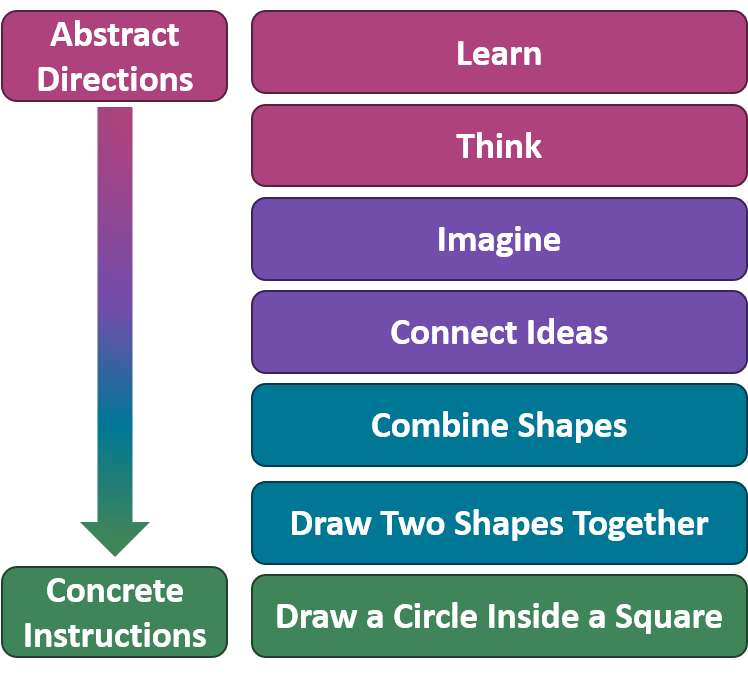Exploring Concrete Examples

Exploring Concrete Examples
Concrete examples use specific, relatable details to support students in developing a connection to and deep understanding of abstract concepts. Concrete examples can be used when introducing a topic to guide students in their understanding and also during retrieval practice to cement the concept in the student’s long-term memory.
Learning Outcomes
After completing this module, you will be able to:
- Explain the principle of concrete examples
- Describe how concrete examples improve learning
- Identify the barriers to using concrete examples
- Demonstrate how to use interactive learning tools to support concrete examples
Understanding Concrete Examples
The principle of concrete examples involves the use of specific, relatable examples to help students understand abstract ideas. Concrete examples may be provided as descriptions, stories, objects, images or models. Examples that students can relate to increase student engagement, clarify concepts, connect to prior learning and enhance understanding and remembering. Examples that model how a student might apply the information not only provide a deeper understanding of the concept, but they can also demonstrate its relevance and guide students through steps to problem-solving.
Consider the idea of “academic success”. Academic success is an abstract concept as it holds different meaning for different people. Because abstract concepts are vague, they are difficult to connect with and remember, and challenging for students to learn. Clarifying using examples that include specific details connect more easily with a student’s existing knowledge and experiences, which makes it easier for the student to retrieve that information from their memory.

Concrete Examples – Video
The following two minute video is an introduction to concrete examples. It explores what concrete examples are and how they can support students in their learning. Feel free to include this short video into your own courses to guide students as they explore effective learning techniques. You can find this video at the following link: Tactic 3: Concrete Examples Video
You can use this video in some interesting and creative ways:
- Present it in class and invite students to share their own concrete examples for a course topic
- Post it in a Study Strategies module in your course and create a student repository of concrete examples using Padlet or a collaborative document.
Concrete Examples – Infographic
You may want to share this infographic with your students to help them understand how they can use concrete examples for learning:
Concrete Examples Infographic.pdf
Attribution- Creative Commons-NonCommercial-NoDerivs by The Learning Scientists
Barriers to Concrete Examples
Within this section we explore some roadblocks that can prevent students from engaging in this particularly learning technique. These can be used in a number of ways:
- establish a reflective checklist for students to assist them in assessing their previous habits and methods of studying
- support discussions about progress and next steps with students
- as a means of feedback to support students while they build their competency with learning
Resistance to Using Concrete Examples
- Developing relevant and meaningful examples, that draw from and connect to experience can take time and effort.
- If an individual feels unfamiliar with the concept, they may not trust their ability to choose an appropriate example.
- Social or cultural differences, or lack of experience, may inadvertently preclude some students from generating or connecting with an example
Challenges Students May Face Using Concrete Examples
- Students may focus on the example rather than on the concept. Multiple examples should be provided, with different details, and an explanation of how the examples relate to the concept. It is important that the focus be directed back to the concept frequently.
- Students may not initially make the connection to the overall concept. It is important to point out the key elements of the concept in the example and then use scaffolding to build deeper understanding of the concept.
- Not all examples that students come up with may be good examples, and students may not be able to accurately assess the accuracy of examples. Providing opportunities for students to obtain feedback on examples they develop will support generation of more, relevant examples and a stronger connection to the concept.
- Institutional diversity may make some examples inaccessible, not understandable or unrelatable for every student. This may cause confusion, reduced connection to or understanding of the concept.
References
Photography on this page used with permission from the Durham College Online Photo Database.
Harvard, B. (2018, January 1). A more concrete classroom. The Effortful Educator. https://theeffortfuleducator.com/2018/01/01/a-more-concrete-classroom/
The Learning Scientists. (n.d.). Concrete examples. The Learning Scientists. https://www.learningscientists.org/concrete-examples
Weinstein, Y., Madan, C.R. & Sumeracki, M.A. (2018). Teaching the science of learning. Cognitive Research: Principles and Implications, 3(2). https://doi.org/10.1186/s41235-017-0087-y
Weinstein Y., & Smith, M. (2016, August 25). Learn to study using… concrete examples. The Learning Scientists. https://www.learningscientists.org/blog/2016/8/25-1
© Durham College. All rights reserved.

